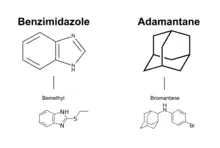Actoprotector
Actoprotectors or synthetic adaptogens are compounds that enhance an organism's resilience to physical stress without increasing heat output.[1] Actoprotectors are distinct from other performance-enhancing substances in that they increase physical and psychological resilience via non-exhaustive action.[1] The term "actoprotector" is used to describe synthetic and isolated compounds possessing adaptogenic properties. By contrast, the term "adaptogen" is most often use to describe a natural herb as a whole, which can contain hundreds if not thousands of biologically active components.[2]
Distinction from psychostimulants
The term actoprotector was coined to distinguish between the pharmacologically distinct mechanism of action of psychostimulant drugs (especially substituted phenethylamines) and actoprotectors. Drugs of both classes can improve resilience to stress, but actoprotectors are presumed to do so via non-exhaustive action.[1]
For example, at least part of the action of bromantane on improving physical resiliency is mediated by upregulation of tyrosine hydroxylase, thereby indirectly increasing dopaminergic signaling in the brain.[3] The action of amphetamine (a phenethylamine psychostimulant) on improving physical resiliency is primarily mediated by induction of dopamine and norepinephrine release from the neuronal vesicles.[4] Clinically, it appears that the anti-asthenic effects of amphetamine quickly disappear within 24 hours of a prior dose,[5] whereas the anti-asthenic effects of bromantane have been found to persist for at least one month after treatment cessation.[6]
Criteria
In a similar fashion to the term nootropic, the term actoprotector maintains various criteria.
- Have minimal [direct] pharmacological activity on biological receptors.[1]
- Facilitate rapid recovery (by reducing central nervous system fatigue).[1]
- Most effective in individuals with low to moderate baseline resilience to stress.[1]
- Involve a complexity of biochemical processes.[1]
- Decrease entropy of an organism (lowering oxygen consumption, body temperature, heart rate, etc).[1]
- Possess efficacy that is independent of extreme conditions.[1]
- Possess the ability to modify the pathology of pathogenic therapy agents (see memantine's use for influenza).[1]
Some compounds may possess actoprotector properties in some areas of their mechanism of action, while not being actoprotectors themselves. For example, the atypical stimulant modafinil appears to dampen amygdala activity independent of its dopaminergic effect,[7][8] and may increase stress tolerance.[7]
Chemical structure

Most actoprotectors fall into several groups depending on their chemical structure:[9]
- Benzimidazole derivatives such as bemitil
- Adamantane derivatives such as bromantane
- Thiazoloindole derivatives
- Succinic acid and 3-hydroxypridine derivatives such as mexidol[10]
List of actoprotectors
References
- Oliynyk S, Oh S (September 2012). "The pharmacology of actoprotectors: practical application for improvement of mental and physical performance". Biomolecules & Therapeutics. 20 (5): 446–456. doi:10.4062/biomolther.2012.20.5.446. PMC 3762282. PMID 24009833.
- "Refections Paper on the Adoptogenic Concept" (PDF). European Medicines Agency. 8 May 2008.
- Morozov, I. S.; Ivanova, I. A.; Lukicheva, T. A. (2001-05-01). "Actoprotector and Adaptogen Properties of Adamantane Derivatives (A Review)". Pharmaceutical Chemistry Journal. 35 (5): 235–238. doi:10.1023/A:1011905302667. ISSN 1573-9031. S2CID 29475883.
- Martin, Dustin; Le, Jacqueline K. (2022), "Amphetamine", StatPearls, Treasure Island (FL): StatPearls Publishing, PMID 32310563, retrieved 2022-08-18
- Lohr, W. David; Wanta, Jonathon W.; Baker, Megan; Grudnikoff, Eugene; Morgan, Wynne; Chhabra, Divya; Lee, Terry (2021-04-20). "Intentional Discontinuation of Psychostimulants Used to Treat ADHD in Youth: A Review and Analysis". Frontiers in Psychiatry. 12: 642798. doi:10.3389/fpsyt.2021.642798. ISSN 1664-0640. PMC 8093505. PMID 33959050.
- Voznesenskaia, T. G.; Fokina, N. M.; Iakhno, N. N. (2010). "[Treatment of asthenic disorders in patients with psychoautonomic syndrome: results of a multicenter study on efficacy and safety of ladasten]". Zhurnal Nevrologii I Psikhiatrii Imeni S.S. Korsakova. 110 (5 Pt 1): 17–26. ISSN 1997-7298. PMID 21322821.
- Rasetti, Roberta; Mattay, Venkata S; Stankevich, Beth; Skjei, Kelsey; Blasi, Giuseppe; Sambataro, Fabio; Arrillaga-Romany, Isabel C; Goldberg, Terry E; Callicott, Joseph H; Apud, José A; Weinberger, Daniel R (September 2010). "Modulatory Effects of Modafinil on Neural Circuits Regulating Emotion and Cognition". Neuropsychopharmacology. 35 (10): 2101–2109. doi:10.1038/npp.2010.83. ISSN 0893-133X. PMC 3013347. PMID 20555311.
- van Vliet, Sanneke A. M.; Jongsma, Marjan J.; Vanwersch, Raymond A. P.; Olivier, Berend; Philippens, Ingrid H. C. H. M. (2006-05-01). "Behavioral effects of modafinil in marmoset monkeys". Psychopharmacology. 185 (4): 433–440. doi:10.1007/s00213-006-0340-4. hdl:1874/19740. ISSN 1432-2072. PMID 16550386. S2CID 12681062.
- Oliynyk, Sergiy; Oh, Sei-Kwan (2012-09-30). "The Pharmacology of Actoprotectors: Practical Application for Improvement of Mental and Physical Performance". Biomolecules and Therapeutics. 20 (5): 446–456. doi:10.4062/biomolther.2012.20.5.446. ISSN 1976-9148. PMC 3762282. PMID 24009833.
- Iakovlieva, I. Iu (2013). "[Mechanisms of actoprotective action of succinic acid's derivatives]". Likars'ka Sprava (3): 78–85. ISSN 1019-5297. PMID 25016753.